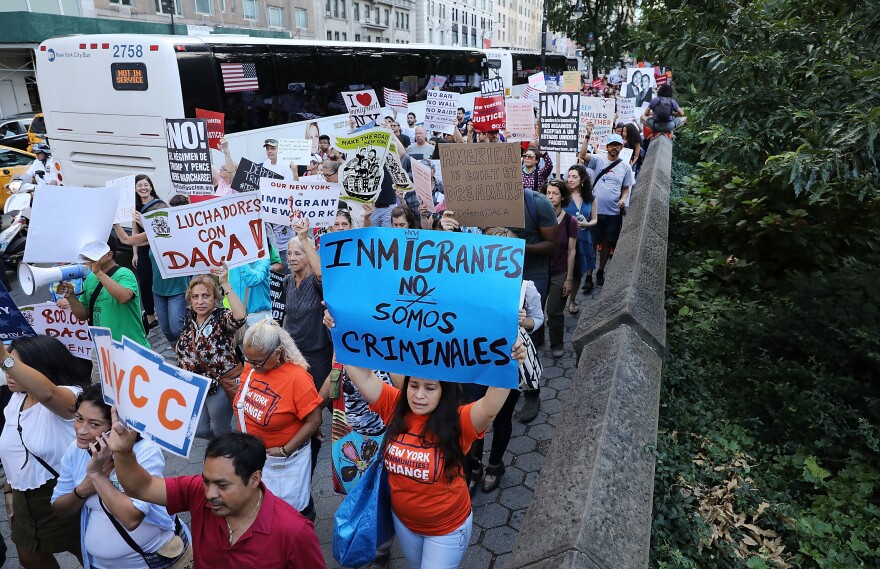As the country looks to CA as a model for gun control, what's the measure of success? The DACA deadline is Thursday, and three recipients weigh in.
Do strict gun laws make for a safer society?
The Sunday shooting in Las Vegas left 59 dead and hundreds more injured. Calls for stricter gun controls have only grown louder in the days since — many from California. The state's gun control laws are among the toughest in the nation, but how do we measure their success? And could California be a model for the country?
Take Two put those questions and more to Adam Winkler, professor of Constitutional law at UCLA.
Several of the gun laws developed in California in recent decades were sparked by gun violence. Walk us through some of them.
California was the first state in the nation to ban military-style assault weapons back in 1989, just months after the killing of five children and wounding of 29 others in Stockton, California.
After the Isla Vista shooting, in which a mentally unstable shooter killed six University of Santa Barbara students and wounded 13 others, California lawmakers authorized gun violence restraining orders, allowing the seizure of guns from people determined by the courts to be a threat to themselves or others.
We saw months after the San Bernardino shooting in 2015 and the Orlando nightclub shooting in 2016, California banned the possession of high-capacity magazines and required background checks for ammunition purchases. So we see a lot of reform, especially in California after these mass shootings.
Is it because California is more of a blue state or is there another reason behind California's ability to get that part of this done?
It's no doubt because California is a blue state in which the NRA just doesn't have the kind of political sway that it has in so many other states.
Since Newton, in fact, in states where the NRA is powerful — most of the southern states — we've seen a flurry of laws passed making it more permissive and making guns more accessible in the wake of Newton.
On Wednesday, in response to the mass shooting in Las Vegas, Senator Dianne Feinstein introduced a bill that would ban "bump fire stocks" nationwide. They're already illegal in California. California has been a bit of a leader in this area. Why is that?
California lawmakers are genuinely concerned in trying to figure out anything they can do to reduce gun violence.
In many parts of the country, the attitude of lawmakers and many voters frankly is that the way to reduce gun violence is more guns. That's not the philosophy here in California. So wherever there's a space that federal law allows the state to regulate, California lawmakers have looked to close those loopholes in federal law.
A lot of California's gun laws were put in place to prevent a repeat of similar incidents. How can you tell if they've been effective? What are the criteria?
It's very difficult. Often, people say 'well, would it have stopped the last mass shooting?' It's always hard to stop something that's happened in the past. And certainly hard to figure out whether the next incident, which may take on totally different facts, will be stopped by a gun control law.
For instance, we had never seen a mass shooting with these bump-fire stocks. The mass shooters change and develop. If we want to figure out how to measure these gun control laws, however, we shouldn't focus on mass shootings specifically.
I think what the goal of gun control should be is to bring down the daily death toll from firearms. If we can just lower those a little bit every day, you make a huge difference in people's lives over the course of a year.
If there turns out to be a federal movement to make gun laws stricter across the nation, can California be held up as a model for the rest of the country to follow somehow?
I think it can be in some ways for sure. California is often a leader in reforms in various areas of political and public life, and gun control may be one of those areas.
Obviously, much of the country has been moving in the opposite direction. California hasn't been able to play that leadership role. But California's taking the initiative to ban these bump fire stocks before the federal government banned them. California has universal background checks that the federal government doesn't have.
At the same time, California does have some laws like its over 15-year-long effort to try to restrict assault weapons that just really hasn't worked effectively and probably won't be a model for reform at the federal level.
Press the blue play button above to hear how weaker gun laws in neighboring states help criminals circumvent California's gun laws.
Answers have been edited for clarity.
LA County looks deeper as WHO raises the alarm on superbugs
Caring is the most valuable currency for LA's homeless in new photo series
Walk or drive almost anywhere in L.A. and you might see tents, blankets, shopping carts — signs of the thousands of people who struggle with homelessness.
While many of us would just keep walking, or maybe offer some spare change, Hans Gutknecht has spent more than a year documenting people without a home. Gutknecht is a photographer with the Los Angeles Daily News, and his work has culminated in a new photo series called "I am...homeless."
The photographs are simple. The subjects are featured in black and white, holding up a whiteboard with a message. Sometimes, the messages are short and plain. Other times they're haunting. But they all resonate.

"I wanted to go out and give people that are living on the street an opportunity to share a message with a bigger audience," Gutknecht said, "to give people a little bit better understanding about them."
Personal messages
"I asked them to share a personal message," Gutknecht said, "or if they could say something to anyone about themselves, what would it be?"
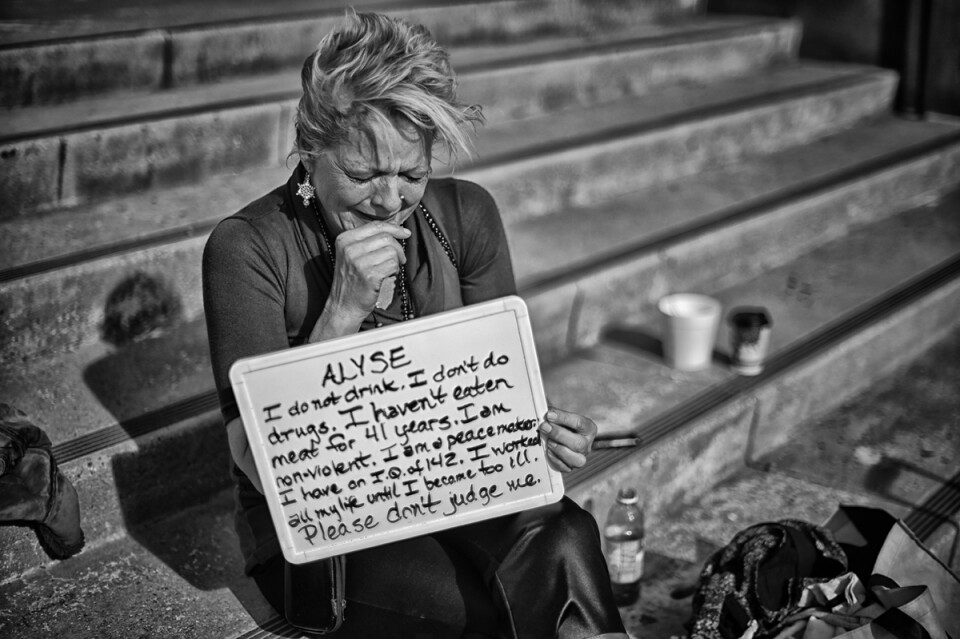
Alyse Heggen, a 56-year-old in Houston, wrote about the constant judgment and poor treatment she received because she is homeless. Among the many other personal messages written on the whiteboard, there were overarching themes of family, religion and loneliness.
"For the most part, people ignore them. Not everybody. You see people that walk by and they'll drop a dollar bill in their cup or they'll hand them a bottle of water. But for every one of those, there's probably 500 or more that just walk right by them. Don't even look at them."
While photographing his subjects, Gutknecht discovered, they did not crave money from Angelenos. Most of them longed for attention or acknowledgment.
"We all crave attention. We all want companionship. We all want to feel like we fit in," Gutknecht said, "and I don't think it's any different for them."
No hope for reform
Los Angeles County is trying to help with homelessness, even eradicate it. As of October 1, a quarter-cent sales tax increase took effect to fund programs to serve and house homeless people. However, many on the street aren't convinced much will change.
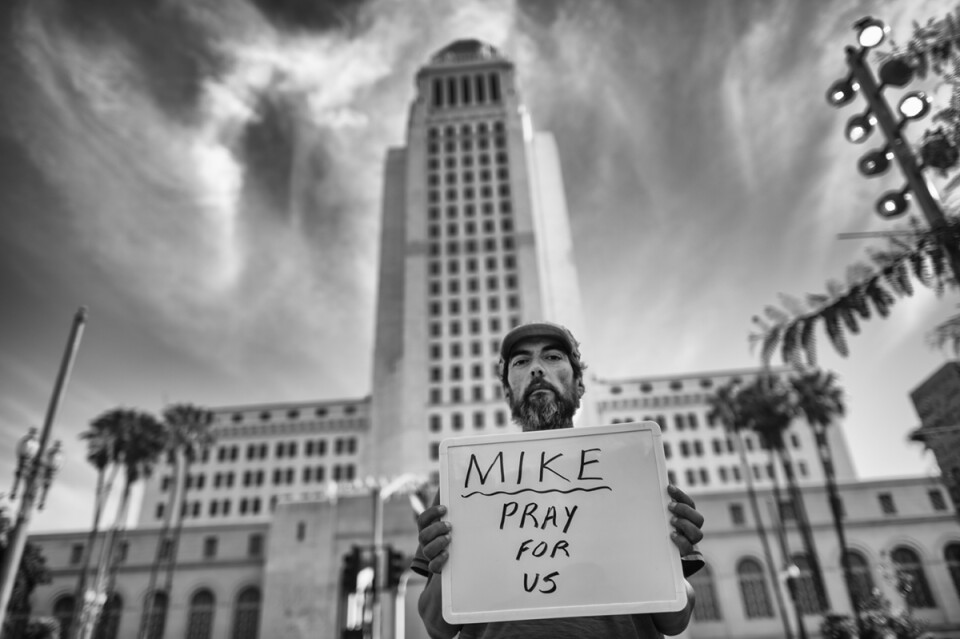
"Most of the people that I encountered didn't express a lot of confidence in the programs. Some would say that people would come around and talk to them and then they would never come back."
Reserve judgment and open up your heart
The series features 50 photographs of different people without a home all throughout Los Angeles County. Gutknecht's message for the audience? Caring and attention is the more valuable currency.
"I hope that people remember that they are human beings and that they are their neighbors. I think any of us, if we had somebody setting up camp in our bushes, is probably going to be unhappy about it.
"But go talk to them. Find out what's going on. Find one of these services that can help them. Don't lump them in the category of, 'Oh, they're a drug addict. Oh, they're an alcoholic. They're mentally ill.' Because they're all not.
"Even if they are, they still deserve to be helped."
To view the series, "I am...homeless." by Hans Gutknecht, click here.
To hear more about the project and Gutknecht's experience documenting the homeless, click the blue play button above.
The Ride: Dockless bike sharing in LA, Tesla misses production goals with Model 3
Bike sharing came to L.A. last year, letting people rent bicycles from one fixed location and return them at another. Now LA City Councilman David Ryu is proposing a new dockless type of bike sharing that lets riders pick up bikes and drop them off almost anywhere.
On Tuesday, Ryu proposed a motion to the city council that would allow LA's Department of Transportation to establish a pilot program for bike sharing that gets rid of the racks for pickup and return. Instead, riders use a smart phone to find a bicycle that's available through the program and unlock it. After riding it around, they leave it wherever they're done, as long as it's within the defined service area. To prevent theft, the bikes automatically lock when the rental is finished.
Dockless advocates say this type of bike sharing will get more bikes into more people's hands because there's more flexibility if riders don't have to go to a set location to get a bike or return it. The easier it is for people to use bicycles to get around, the more likely they are to use bicycles instead of a car.
Ryu's motion needs approval from the city council before a pilot program could take effect, but dockless bike sharing could make its LA debut next year.
Next year is also when most reservation holders for the Tesla Model 3 are likely to get their cars. On Monday, the electric car company acknowledged it had fallen fall short of its production goals, making just 260 Model 3s between July and the end of September. When the Model 3 went into production in July, Tesla CEO Elon Musk had said 1,500 would be built by now.
No Place Like LA: Paul, finding his LA identity in Texas
No Place Like LA is our new series that asks transplants and immigrants to LA, "When was the moment you felt that Los Angeles was truly home?"
THIS IS Paul Koehler FROM LA'S STORY
I am originally from Milwaukee, Wisconsin, and I moved to Los Angeles in 2012.
The moment I became an Angeleno? It didn't even happen in Los Angeles.
It happened in Texas.
I was in Dallas for a business trip. My colleagues and I stopped at a diner.
Waitress looked at us and said, "Oh, where are you from?"
Up until that time, I had answered people, "Well, I'm originally from the Midwest and I lived in Japan for a long time and then I moved [to LA]."
But that was the first time I had said, "Oh, I'm from Los Angeles."
Took two years, but by that point I had realized I cut out most of my background and I felt at that time I really felt like I was at home.
It's home for me.
Tell us your own story, too.
An uncertain future looms for local DACA recipients
Since 2012, the Deferred Action for Childhood Arrivals program, or DACA, has offered certain protections to undocumented immigrants brought to the US as children. Through DACA, over 200,000 young immigrants in California gained legal access to driver's licenses, college enrollment, and employment.
Today, there's a lot of uncertainty for DACA recipients. Last month, the Trump administration announced their plan to phase out the Obama-era program by next March, and that today would be the last day to renew their status.
There are efforts in Congress to pass an immigration bill that would provide permanent, legal status for DACA recipients but in a politically divided climate, and with so much in flux around immigration policy, how are DACA recipients and their families planning for the future?
To find out, Take Two's A Martinez hosted a roundtable of three DACA recipients raised in Southern California.
Yael Pineda

Yael works at the Dream ResourceCenter at UCLA. She received her DACA status in 2013.
Since the White House announced the eventual end of DACA, Yael's sense of fear has increased "ten times more."
I feel more fearful about being undocumented. It’s a reality that’s hit me in the face. The fear that I grew up with as a child, it increased by like, ten times more…. A terrible sense of panic and anxiety. I don’t know what direction my life is going. I think it’s difficult enough being in your early twenties. But now, with the end of DACA, I don’t know if I were to enroll into a graduate program, what will happen in 2018 when my DACA ends? If I don’t get a job, how am I going to pay for that graduate program? And so, the instability of my life has really changed my plans for the future and for my career.
The end of DACA has made her think twice about who she tells about her status.
That whole slogan, ‘undocumented and unafraid,’ I’ve taken a step back from it – maybe half a step – just because I’m more aware and more wary of who I do tell my status to. I refrain more from telling people who are white just because honestly... when I see a white person, it’s kind of like, do they hate me? Are they willing to commit some sort of atrocity against me and that actually puts me into a lot of fear…? You don’t know who is so against people of color so that’s a very big fear that I think a lot of us share, unfortunately.
Regardless of whether I’m afraid or not, I need to continue to tell my story just because by telling my story – maybe I’m the first undocumented person that they know, so that will raise their awareness and their empathy towards undocumented people and people of color in general.
Yael isn't willing to settle for less than comprehensive reform.
As we’ve seen in 2009 and 2010 when the Democrats had power of the Senate and the House, no steps were taken. And so now, we see the Democrats saying, oh well the Republicans have control of the government and of Congress, and so there’s nothing that we can do. But, in reality, they’ve had control and power in the past decade, and nothing, nothing has been done for the 11-million-plus undocumented immigrants. So, if a comprehensive immigration reform is not passed, I would not be willing to sign up for that.
Vlad Stoicescu Ghica
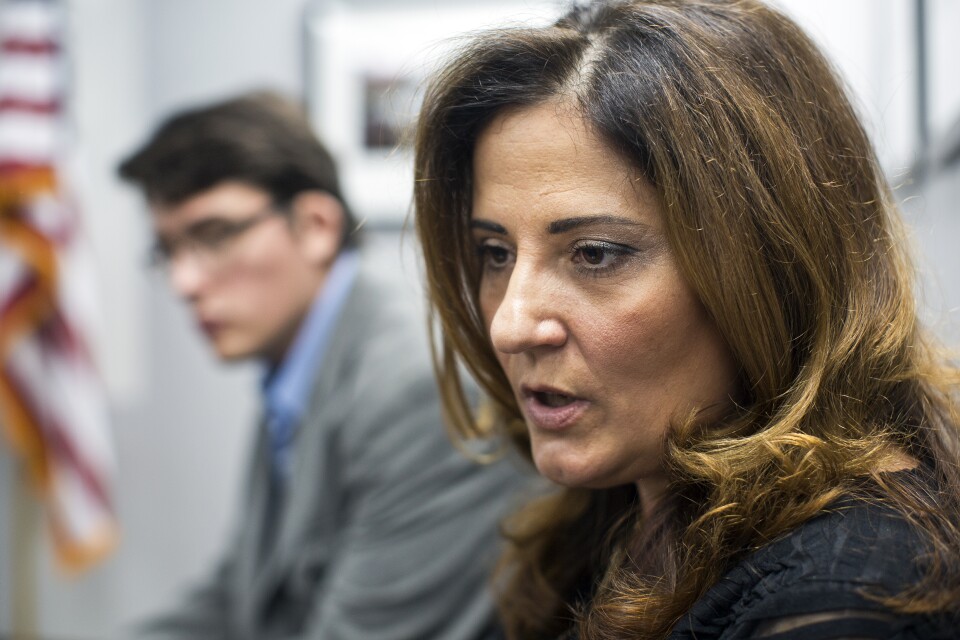
Vlad is a masters student in the school of public policy at UC Berkeley. He received his DACA status in 2013.
Now that Vlad is facing a future without DACA protections, he has to rethink his long-term plans.
When I initially received my DACA, I was still an undergraduate student at UCLA and I was struggling very much to pay bills at home, to pay for tuition, to pay for books, to pay for meals everyday. And being able to work part time the way I did with my DACA, it allowed me to really begin taking control of my life and to make ends meet. So that was hugely impactful to me.
And I also began making a long term plan for myself; working, pursuing a graduate degree, driving a car, renting an apartment – these were all things that were very feasible when you have DACA. I’m now in a position where I have to reconsider my long-term plan.
Vlad's worried that DACA protections could be leveraged against other immigrants, like his mother.
My big concern is that a big comprehensive push right now would actually come out against a lot of people. That those of us who have DACA would be kind of put on this pedestal and everyone else would be left behind. And we’d be used as a bargaining chip for more enforcement.
He's prepared to keep advocating, even if he has to do it without his family.
That’s really more coming from this idea that if I see something wrong, I think the right thing to do is to fight back against it and to try to change it. So, I think I would want to go back to Romania but instead I would want to stay here where I grew up even if my family members were taken away. I think what they would want me to do is to make that sacrifice that they’ve made worth it. And to try to organize and to do work here in order to change the thing that did that damage.
It’s been over four years since a comprehensive immigration reform bill was on the table. We’ve been in this limbo status of DACA for a number of years. But it was always with the promise of, something’s coming… meanwhile, we saw deportations really escalate under the Obama administration. We saw the Trump campaign really take root and take shape. In that sense I want to say I’m pessimistic because things have been intransigent for a very, very long time. And it might not seem like that on the outside but with regards to our personal lives, and our personal status shifting, nothing has really been on the table for a long time.
But the optimism in me comes from this idea that people are starting to take notice again. We are in a position now – if we all continue to do the work, and to share our stories, and to organize within our communities – to begin this conversation again around the justice that needs to take place in undocumented communities here in the United States. And things that go beyond just those of us who are impacted by this immediate DACA decision.
Jose Jaspeado
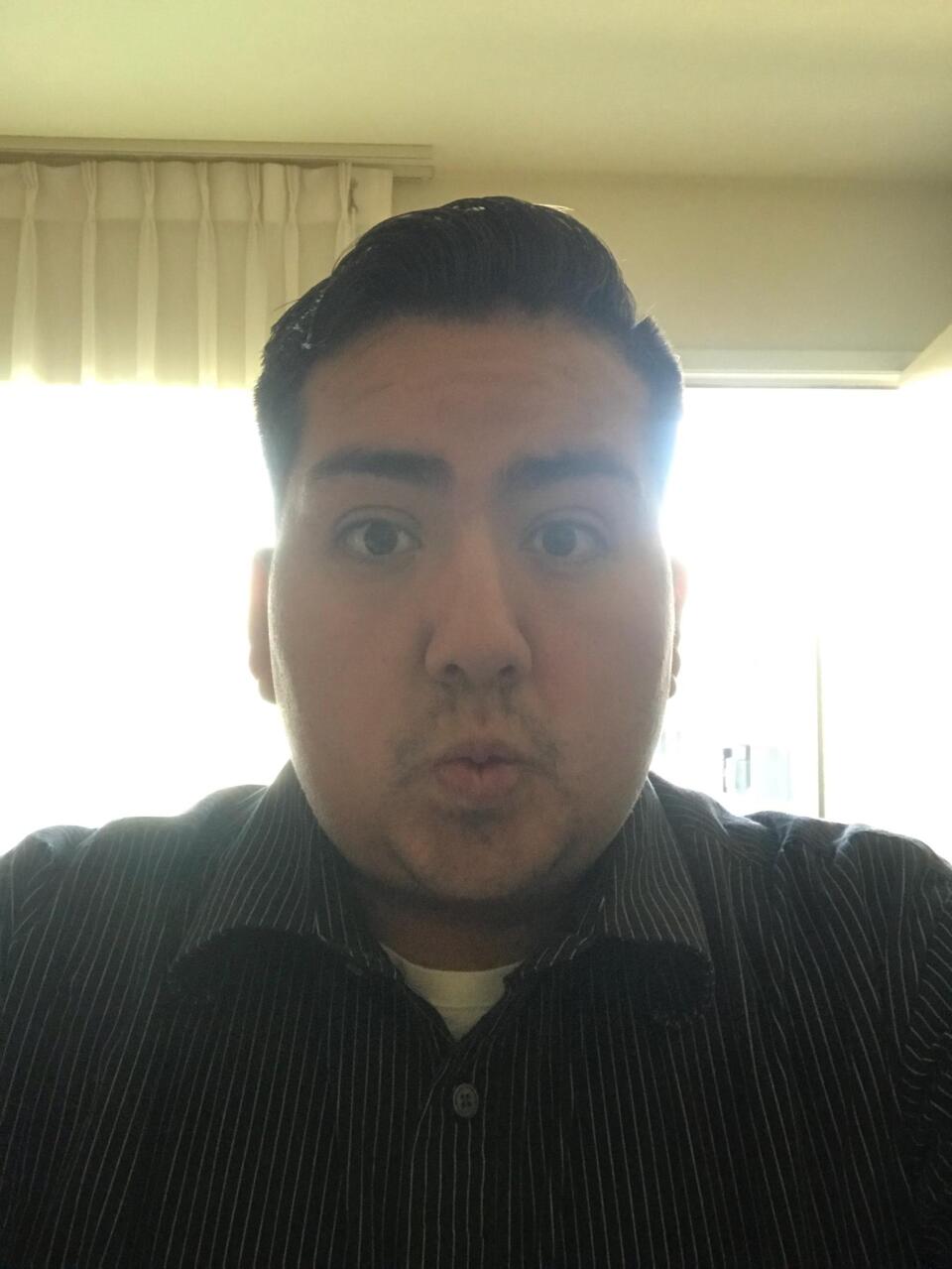
Jose works with the Food Chain Workers Alliance. He received his DACA status in 2014.
Living without DACA will mean returning to a former way of life.
To me, I’ve been undocumented my whole life, so I’m not scared of going back into the undocumented life. I do have to say, I enjoyed my DACA like everybody else did.
Jose is worried that a bill from Congress would mean leaving his parents' generation behind.
I feel like they’re focusing on the dreamer mentality and they’re only trying to support those who have DACA. It’s not just the folks who have DACA. It’s the 11 million undocumented families that are in the United States. So, I really don’t support any of them until they start supporting every undocumented person. I feel like my parents were the original dreamers. They had a dream. They came to the United States. A lot of people are throwing them under the bus because they’re saying they did something illegal by bringing us here, but they actually are the folks that we should be focusing on.
I feel like this band-aid stopped a lot of us from organizing because we were living our lives, and we totally forgot about our families. And now it’s time to make sure that they don’t get left behind. And we need to put something that will focus on all the undocumented folks.
Wherever Jose's family has to go, he will go with them.
I could not stay and let my family go back. If that was the choice – they were going to deport my whole family – I would go and deport myself to Mexico, where I was born, and start organizing there to make sure that this doesn’t happen.
Ultimately, Jose believes that with enough engagement, they can change immigration policy.
I organize with an organization called DREAM Team Los Angeles. When DACA was announced, a lot of our DTLA members started disappearing. And I’ve seen now, a new wave of… people trying to organize. If we continue to organize… having civil disobedience… fighting for what’s right, we will get what we want.



